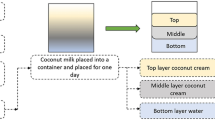Abstract
The physico-chemical characteristics of the seeds and seed oils of four citrus species, Mitha (Citrus limetta), Grapefruit (Citrus paradisi), Mussami (Citrus sinensis), and Kinnow (Citrus reticulata) were investigated. The hexane-extracted oil content of citrus seeds ranged from 27.0 to 36.5%. The protein, fiber and ash contents were found to be 3.9–9.6%, 5.0–8.5%, and 4.6–5.6%, respectively. The extracted oils exhibited an iodine value of 99.9–110.0; refractive index (40 °C), 1.4639–1.4670; density (24 °C), 0.920–0.941 mg/mL; saponification value, 180.9–198.9; unsaponifiable matter, 0.3–0.5%; acid value (mg KOH/g of oil), 0.5–2.2 and color (1-in. cell) 1.4–3.0R + 15.0–30.0Y. The oils revealed a good oxidative stability as indicated by the determinations of specific extinctions at 232 and 270 nm (2.3–4.4 and 0.6–0.9, respectively), p-anisidine value (2.2–3.2) and peroxide value (1.6–2.4 mequiv/kg of oil). The citrus seed oils mainly consisted of linoleic acid (36.1–39.8%). Other prominent fatty acids were palmitic acid (25.8–32.2%), oleic acid (21.9–24.1%), linolenic acid (3.4–4.4%), and stearic acid (2.8–4.4%). The contents of tocopherols (α, γ, and δ) in the oil were 26.4–557.8, 27.7–84.1, and 9.1–20.0 mg/kg, respectively. The results of the present study demonstrated that the seeds of citrus species investigated are a potential source of valuable oil which might be utilized for edible and other industrial applications.


Similar content being viewed by others
References
Singh U, Wadhwani AM, Johri BM (1983) Dictionary of economic plants in India, 2nd edn. Indian Council of Agricultural Research (ICAR), New Delhi, pp 51–53
Mahmood MA (2005) Hurdles in way of citrus export. Dawn. http://www.dawn.com/2005/10/31/ebr4.htm. Cited 31 Oct 2005
Khan SRA (2005) Citrus quality to meet global demand. Pakistan agriculture overview. http://www.pakissan.com/english/agri.overview/index.shtml. 25 Nov 2005
El-Adawy TA, Rehman EH, El-Bedawy AA, Gafar AM (1999) Properties of some citrus seeds. Part 3. Evaluation as a new source of potential oil. Nahrung 43:385–391
Silalahi J (2002) Anticancer and health protective properties of citrus fruit components. Asia Pac J Clin Nutr 11:79–84
Schulz H, Schrader B, Quilitzsch R, Steuer B (2002) Quantitative analysis of various citrus oils by ATR/FT-IR and NIR-FT Raman spectroscopy. Appl Spectrosc 56:117–124
Saidani M, Dhifi W, Marzouk B (2004) Lipid evaluation of some Tunisian citrus seeds. J Food Lipids 11:242–250
Reda SY, Sauer EL, Batista AEC, Barana AC, Schnitzel E, Carneiro PIB (2005) Characterization of rangpur lime (Citrus limonia Osbeck) and “Sicilian” lemon (Citrus limon) seed oils, an agro-industrial waste. Cienc Technol Aliment 25:672–676
Habib MA, Hammam MA, Sakr AA, Ashoush YA (1986) Chemical evaluation of Egyptian citrus seeds as potential sources of vegetable oils. J Am Oil Chem Soc 3:1192–1197
Ajewole K, Adeyeye A (1993) Characterization of Nigerian citrus seed oils. Food Chem 47:77–78
Trandjiska R, Nguyen H (1989) Triglyceride composition of seed oils from Vietnamese citrus fruits. Riv Ital Sost Grasse 66:99–100
Ramadam MF, Sharanabasappa G, Seetharam YN, Seshagiri M, Moersel JT (2006) Characterization of fatty acid and bioactive compounds of kachnar (Bauhinia purpurea L.) seed oil. Food Chem 98:359–365
Association of Official Analytical Chemists (AOAC) (1990) Official methods of analysis of the association of official analytical chemists, 15th edn. AOAC Inc., Arlington, Method 954.01
International Organization for Standardization (ISO) (1981) Animal feeding stuffs—determination of nitrogen and calculation of crude protein contents. ISO, Geneva, Standard No. 5983
International Organization for Standardization (ISO) (1977) Oilseeds residues—determination of total ash. ISO, Geneva, Standard No.749
American Oil Chemist’s Society (AOCS) (1997) Official and recommended practices of the American Oil Chemists Society, 5th edn. AOCS Press, Champaign
International Union of Pure and Applied Chemistry (IUPAC) (1987) In: Paquot C, Hautfenne A (eds) Standard methods for the analysis of oils, fats and derivatives, 7th revised and enlarged edn. Blackwell Scientific, London
Wrolstad RE (2003) Analysis of tocopherols and tocotrienols. In: Wrolstad RE (ed) Current protocols in Food Analytical Chemistry (CPFA). Wiley, New York
Saleem M, Sarwar M, Khan SA, Bhatty MK (1977) Fatty acids of indigenous resources for possible industrial applications. Pakistan J Sci Ind Res 20:305–306
Pritchard JLR (1991) Analysis and properties of oilseeds. In: Rossell JB, Pritchard JLR (eds) Analysis of oilseeds, fats and fatty foods. Elsevier Applied Sciences, New York, pp 39–102
Akpata MI, Akubor PI (1999) Chemical composition and selected functional properties of sweet orange (Citrus sinensis) seed flour. Plant Foods Hum Nutr 54:353–362
Hamid S, Liaquat L, Khalid B, Khan JI (2003) Lipids in Citrus sinensis seeds. Proc Pakistan Acad Sci 40:159–164
Rossell JB (1991) Vegetable oil and fats. In: Rossell JB, Pritchard JLR (eds) Analysis of oilseeds, fats and fatty foods. Elsevier Applied Sciences, New York, pp 261–319
Manzoor M, Anwar F, Iqbal T, Bhanger MI (2007) Physico-chemical characterization of Moring concanensis seeds and seed oil. J Am Oil Chem Soc 84:413–419
Jelen HH, Obuchowska M, Zawirska-Wojtasiak R, Sowicz EW (2000) Headspace solid-phase micro extraction use for the characterization of volatile compounds in vegetable oils of different sensory quality. J Agric Food Chem 48:2360–2367
Anwar F, Latif S, Ashraf M (2006) Analytical characterization of hemp (Cannabis sativa) seed oil from different agro-ecological zones of Pakistan. J Am Oil Chem Soc 83:323–329
Malaysian Palm Oil Council (2007) Competitiveness bodes well for Pakistan: Closer look at the most consistent market for Malaysian palm oil. Malaysian Palm Oil Fortune 3:1–4
Shah NA, Shah H, Akmal N (2005) Sunflower area and production variability in Pakistan: opportunities and constraints. HELIA 28(43):165–178
Author information
Authors and Affiliations
Corresponding author
About this article
Cite this article
Anwar, F., Naseer, R., Bhanger, M.I. et al. Physico-Chemical Characteristics of Citrus Seeds and Seed Oils from Pakistan. J Am Oil Chem Soc 85, 321–330 (2008). https://doi.org/10.1007/s11746-008-1204-3
Received:
Revised:
Accepted:
Published:
Issue Date:
DOI: https://doi.org/10.1007/s11746-008-1204-3




